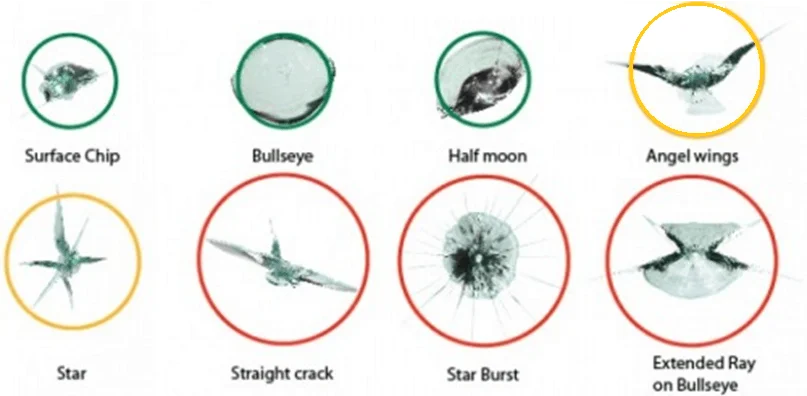Your windshield is one of the most critical components of your vehicle, providing structural integrity and clear visibility while driving. However, it’s also one of the most vulnerable to damage from road debris, especially stone chips. Understanding the different types of stone chips can help you determine whether you need a quick repair or a full windshield replacement.

Common Types of Windshield Stone Chips
Common Types of Windshield Stone Chips
Stone chips come in various shapes and sizes, each with different implications for repair. Here are the most common types:
1. Surface Chip
- Description: A minor chip that only affects the outer layer of glass.
- Repairability: Usually repairable with a resin application if caught early.
2. Bullseye
- Description: A circular damage pattern resembling a target, typically caused by a small rock.
- Repairability: Often repairable if the damage is smaller than a quarter.
3. Half Moon
- Description: Similar to a bullseye but with an incomplete circular shape.
- Repairability: Can often be repaired, depending on size and depth.
4. Angel Wings
- Description: A crack that forms two opposing wings extending from the impact point.
- Repairability: May require replacement if the cracks extend too far.
5. Star
- Description: A central impact point with several small cracks radiating outward.
- Repairability: Can be repaired if the cracks are not too extensive.
6. Straight Crack
- Description: A single crack extending from the point of impact.
- Repairability: Short cracks (under six inches) can sometimes be repaired; longer cracks may require windshield replacement.
7. Star Burst
- Description: A more complex star pattern with multiple deep cracks spreading outward.
- Repairability: Usually requires replacement as the cracks can compromise the windshield’s strength.
8. Extended Ray on Bullseye
- Description: A combination of a bullseye with a crack extending outward.
- Repairability: Repairable in some cases, but a replacement may be necessary if the crack spreads.
Why Timely Repairs Matter
Stone chips and cracks can spread over time due to temperature changes, vibrations, and additional stress on the windshield. A small chip today could turn into a large crack tomorrow, leading to costly replacements. Timely repairs help maintain the structural integrity of your windshield and ensure your safety.
What to Do If You Notice a Chip
- Inspect the Damage: Determine the size, shape, and depth of the chip.
- Act Quickly: The sooner you repair a chip, the better the chances of preventing further damage.
- Consult a Professional: Many minor chips can be repaired using specialized resins, but larger or deeper cracks often require windshield replacement.
Final Thoughts
Understanding the different types of stone chips can help you make informed decisions about repairs and replacements. If you notice damage on your windshield, don’t wait—get it inspected by a professional to ensure your safety on the road.
By recognizing and addressing windshield damage early, you can save money, maintain clear visibility, and ensure the durability of your vehicle’s glass
